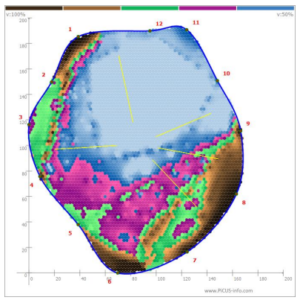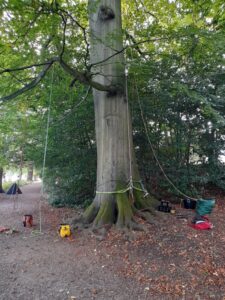If you’ve visited Harewood this week, you’ll have seen that part of the Lakeside Walk is closed as some arboricultural work is done on a beautiful beech tree on the path.
Arboriculture – or the cultivation, management and study of trees and shrubs – is a constant feature of life at Harewood, with thousands of trees within the grounds that need careful attention for the tree’s health and for visitor safety. This beech is rotting, so it’s being reduced by 40% to keep it standing and alive for many more years.
The beech from the other side of the lake – the tallest tree in the centre of the image.
Examining the beech tree
This particular tree is a beech, Fagus sylvatica, approximately 300 – 350 years old. Toadstools (which are the fruiting bodies) of the fungus Pholiotus, ‘Shaggy parasol’, which grows on rotten wood, began to appear on the tree, which prompted us to look deeper into the tree’s physical state.
PiCUS tomography measures sound waves as they travel through the tree. The solidity of the wood dictates how fast they travel, allowing us to see a cross section through the stem.
The brown on this tomograph shows good healthy wood; green is wood in transition; and purple & blue shows rotten/dead wood. A tree can still be very stable if it has at least 70% brown around the outside, but as we can see, our beech has gone beyond this point.
This is a resistograph, showing the results of drilling into the root buttresses with a very fine, long drill. The amount of resistance the drill encounters gives an idea of how solid the wood is, up to a metre’s depth.
A further proof of the tree’s internal rooting is the Ganoderma fungus, ‘Beech heart-rot’ – this has just started to show on the surface, and has caused the dead wood inside.
Reducing the tree
We were advised to reduce the height of the beech by 40%. This reduces the weight that needs to be borne by the rotting stem, as well as mitigating the ‘wind sail’ effect. The smaller tree should stand for many more years; without the reduction, we might have seen the tree fall across the path within one or two years.
Arborists who have taken care of Harewood’s trees for many years are on site this week. They have rigged up an ‘English Reeve’, a rope system, between our beech and a large tree a few metres down the path (requiring around 500m of rope!). This will allow them to move the cut branches at canopy level, then drop them onto a clear section of path, to avoid damaging any smaller trees under the beech.
The beech with its rigging
The view across the lake may look slightly different, but we’re glad that this work will keep a beautiful tree standing for years to come.




